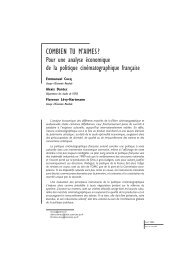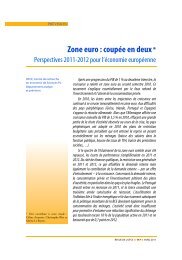direct multi-step estimation and forecasting - OFCE - Sciences Po
direct multi-step estimation and forecasting - OFCE - Sciences Po
direct multi-step estimation and forecasting - OFCE - Sciences Po
Create successful ePaper yourself
Turn your PDF publications into a flip-book with our unique Google optimized e-Paper software.
Direct <strong>multi</strong>-<strong>step</strong> <strong>estimation</strong> <strong>and</strong> <strong>forecasting</strong><br />
first <strong>step</strong>—model at each horizon.<br />
The purpose of this article is to review the main contributions to the <strong>multi</strong>-<strong>step</strong> <strong>forecasting</strong><br />
literature <strong>and</strong> to show how they arose in order to provide a unifying treatment of the many<br />
distinct existing results. We first need to explain what we mean by <strong>direct</strong> <strong>multi</strong>-<strong>step</strong> <strong>forecasting</strong> as<br />
its definition has emerged only progressively <strong>and</strong> we think preferable not to define it at this stage<br />
but after reviewing the various contributions: this concept has historically served as an umbrella<br />
for different approaches <strong>and</strong> only one has proved useful in <strong>forecasting</strong>.<br />
Let us only clarify for<br />
now that the traditional <strong>estimation</strong> method consists in estimating, for a vector variable x t , the<br />
equation relating it to its past <strong>and</strong>, potentially, to additional variables. If we denote by F t , the<br />
sigma-field representing the information available at time t, the traditional method seeks to model<br />
<strong>and</strong> estimate how x t is generated given F t−1 , or x t |F t−1 , so as to produce an equation such that:<br />
x t = ̂f (F t−1 ) , for t ≤ T. (1)<br />
From a date T , when F T is available, it is therefore possible, using the estimated (1), to generate<br />
a forecast for T + 1, namely<br />
̂x T +1|T = ̂f (F T ) ,<br />
assuming that the intertemporal link between x t <strong>and</strong> F t−1 will remain valid in the future. When<br />
F T is generated only by {x t } t≤T<br />
, the same assumption about x T +h <strong>and</strong> F T +h−1 , for h > 1, leads<br />
to replacing F T +1 by ̂F T +1 which we regard as pseudo information relating to { ..., x T , ̂x T +1|T<br />
}<br />
where ̂x T +1|T is assumed to be authentic information (in reality ̂F T +1 = F T ), so that we produce:<br />
̂x T +2|T = ̂f<br />
(<br />
̂FT +1<br />
)<br />
,<br />
<strong>and</strong> so on, for higher forecast horizons. We define the resulting forecasts as iterated <strong>multi</strong>-<strong>step</strong> or<br />
IMS.<br />
By contrast, an alternative method consists in <strong>direct</strong>ly estimating the relationship of interest<br />
at the hth horizon, namely x t |F t−h , so that a DMS forecast is generated by<br />
˜x T +h|T = ˜k h (F T ) .<br />
Care must be paid to the terms used: the one-<strong>step</strong> (1S) parameter estimates (which coincide for<br />
both IMS <strong>and</strong> DMS at h = 1) are those obtained for ̂f (·), they imply some IMS counterparts by<br />
4








